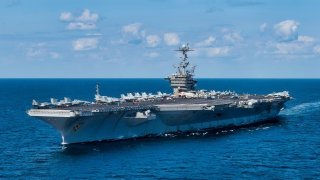The Secret Reason the Age of the Aircraft Carrier Is Over
The U.S. Navy’s carrier strike groups face increasing threats from advanced missile technologies, such as Russia’s Kh-47M2 Kinzhal and China’s DF-26 and DF-21 "carrier-killing" missiles. Staying out of range of these missiles is a serious problem
Summary: The U.S. Navy’s carrier strike groups face increasing threats from advanced missile technologies, such as Russia’s Kh-47M2 Kinzhal and China’s DF-26 and DF-21 "carrier-killing" missiles.
-The limited range of U.S. Navy’s strike fighters, like the F/A-18E/F Super Hornets and F-35 variants, necessitates carriers to operate within enemy missile range, posing significant risks.
-However, new tactics and technologies, including the use of the MQ-25 Stingray drone for refueling, and deployment of long-range weapons like the AGM-84 Harpoon and AGM-158C LRASM, aim to mitigate these risks by allowing carriers to maintain safe distances while effectively targeting adversaries.
The U.S. Navy Aircraft Carrier and the Range Problem
As U.S. adversaries continue to build up their respective missile and drone capabilities, the Navy’s carrier strike group could be in trouble. Russia possesses its Kh-47M2 Kinzhal hypersonic air-launched ballistic missile, which has already been deployed to strike targets in Ukraine.
China employs the DF series of missiles, particularly the 26 and 21 variants, both of which are formidable “carrier-killing” missiles.
Tensions in eastern Europe and the South China Sea are escalating every day, suggesting that the potential use of these lethal weapons could be employed against American assets if war breaks out.
The problem with U.S. strike fighters-range
The Navy’s aerial fleet of cutting-edge strike fighters may be world-renowned, but they lack the range needed to go up against the shore-based defensive missiles. The Boeing F/A-18E/F Super Hornets have a combat range of roughly 500 miles with a nearly full weapons-load while the F-35A and C variants have about double that range.
If these strike fighters were to engage in blue water operations over the open ocean or in the vast reaches of a potential Indo Pacific battlefield, every extra mile counts, however, the carriers would still have to place themselves in range of the shore-based missiles to launch and recover their aircraft.
How to better protect the aircraft carrier:
While these defenses do represent a serious threat to carriers, they should not be completely counted out. Planners are well aware of the potential dangers facing carrier strike groups and are working to mitigate that risk.
The MQ-25 Stingray drone is a semi-stealth carrier-based aircraft which could serve as an inflight refueling store for strike fighters. It could launch with the fighters far out to sea and ensure they have enough gas to get to their targets and then either remain on station to meet them when they return or trade places with another Stingray launched later.
Any conflict with China or Russia could progress to striking targets within those countries however the Navy would most likely initially be focused on degrading their opponents Navy to allow other assets to get closer to the coast.

To accomplish this, the Navy has developed and employed several air-launched long range weapons: the AGM-84 Harpoon anti-ship missile, the AGM-154 Joint Stand Off Weapon, and the AGM-158C Long Range Anti-Ship Missile. Each of these has an extended range that allows carriers to launch their strike fighters from far out to sea. These fighters would employ from tens to hundreds of miles from the enemy fleet before returning to the boat. This means the carrier could maintain a standoff of potentially 1,000+ miles from shore yet still strike at enemy fleets.
While the range of the Navy’s strike fighters may be limited, advances in technology and changes in tactics can rectify the potential danger this could cause to carriers.
About the Author: Maya Carlin
Maya Carlin, National Security Writer with The National Interest, is an analyst with the Center for Security Policy and a former Anna Sobol Levy Fellow at IDC Herzliya in Israel. She has by-lines in many publications, including The National Interest, Jerusalem Post, and Times of Israel. You can follow her on Twitter: @MayaCarlin.


